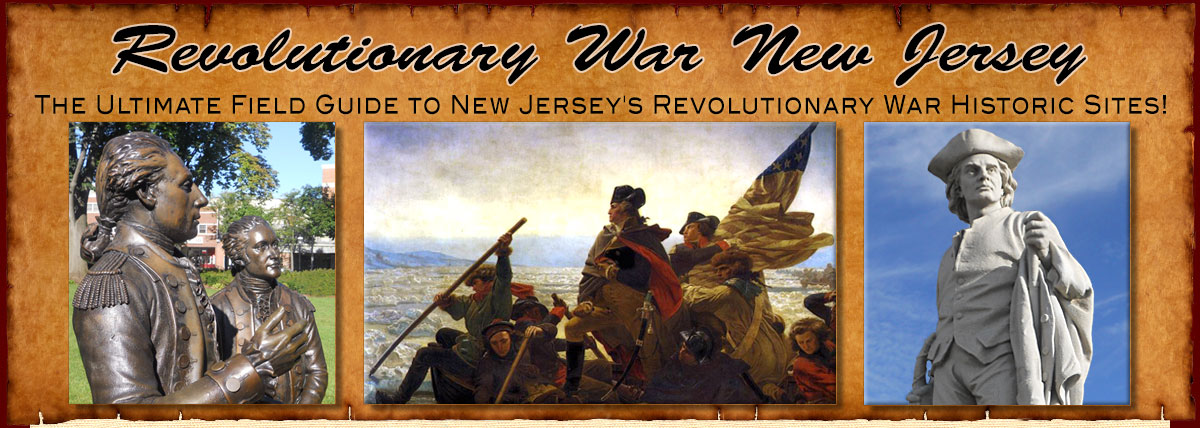

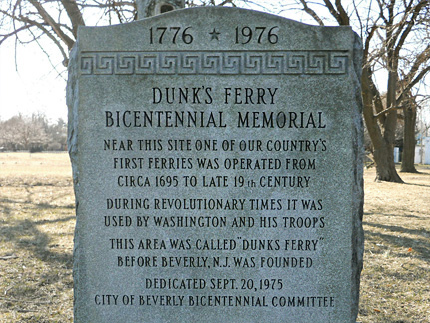
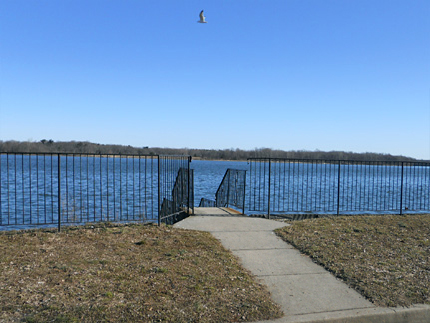
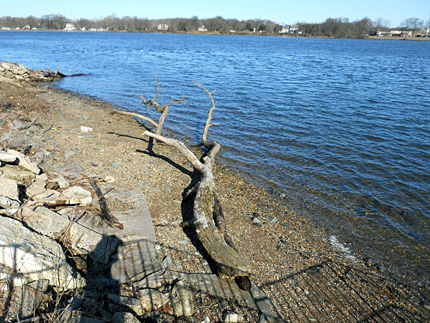
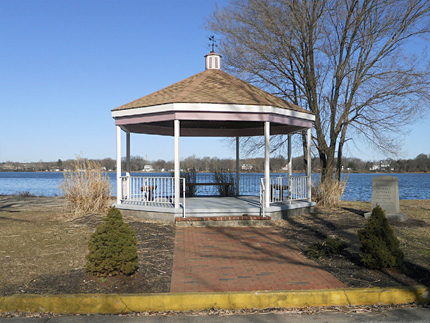
Dunk's Ferry Memorial
Bank Rd.
Map / Directions to the Dunk's Ferry Memorial
General Washington made his famous crossing of the Delaware River on the night of December 25, 1776. Washington crossed the river from Pennsylvania into New Jersey for a surprise attack on the Hessian garrison at Trenton, resulting in the American victory at the first Battle of Trenton. However, Washington's original plan had been more elaborate. He had divided his attacking army into three sections, each of which were to cross the Delaware River at different locations.
Washington successfully crossed the Delaware River with 2,400 men about ten miles upstream from Trenton. However, the other two crossings were unsuccessful, due to the conditions of the icy river on that cold winter night. One of the unsuccessful attempts was made by troops under General James Ewing at Trenton.
The other unsuccessful crossing attempt was made by troops under the command of General John Cadwalader at Dunk's Ferry, downstream from Trenton. Their role in the plan was to create a diversion to the Hessians south of Trenton. While about 600 infantry troops were able to make it across at Dunk's Ferry to the New Jersey side of the river, the attempted crossing was abandoned because the artillery could not be transported.[1]
One of the infantrymen who made it across the river was Captain Thomas Rodney, the younger brother of Declaration of Independence signer Caesar Rodney. Captain Thomas recorded the following account in his diary: [2]
"When we reached the Jersey shore we were obliged to land on the ice, 150 yards from the shore; the River was also very full of floating ice, and the wind was blowing very hard, and the night was very dark and cold, and we had great difficulty in crossing but the night was very favorable to the enterprise. We advanced about two hundred yards from the shore and formed in four columns of double files.
"About 600 of the light troops got over, but the boats with the artillery were carried away in the ice and could not be got over.
"After waiting about 3 hours we were informed that Gens. Cadwalader and Hitchcock had given up the expedition, and that the troops that were over were ordered back. This greatly irritated the troops that had crossed the River and they proposed making the attack without both the Generals and the artillery but it was urged, that if Gen. Washington should be unsuccessful and we also, the cause would be lost, but if our force remained intact it would still keep up spirit of America; therefor this course was abandoned.
"We had to wait about three hours more to cover the retreat, by which time the wind blew very hard and there was much rain and sleet, and there was so much floating ice in the River that we had the greatest difficulty to get over again, and some of our men did not get over that night. As soon as I reached the Pennsylvania shore I received orders to march to our quarters, where I arrived a little before daylight very wet and cold. "
The Dunk's Ferry Memorial is in a small park alongside the Delaware River. There are park benches, a gazebo, and a great view of the river.

1. ^ • David Hackett Fischer, Washington's Crossing (New York: Oxford University Press, 2004) Pages 206-220
• “From George Washington to Colonel John Cadwalader, 25 December 1776,” Founders Online, National Archives (http://founders.archives.gov/documents/Washington/03-07-02-0342 [last update: 2015-06-29]). Source: The Papers of George Washington, Revolutionary War Series, vol. 7, 21 October 1776–5 January 1777, ed. Philander D. Chase. Charlottesville: University Press of Virginia, 1997, pp. 438–439.
• “From George Washington to Colonel John Cadwalader, 25 December 1776,” Founders Online, National Archives (http://founders.archives.gov/documents/Washington/03-07-02-0343 [last update: 2015-06-29]). Source: The Papers of George Washington, Revolutionary War Series, vol. 7, 21 October 1776–5 January 1777, ed. Philander D. Chase. Charlottesville: University Press of Virginia, 1997, p. 439.
2. ^ Thomas Rodney, Diary of Captain Thomas Rodney, 1776-1777 (Wilmington, DE: Historical Society of Delaware, 1888) Pages 21-24
Available in Google Books here.
Rodney's diary entries for December 25 and 26 include more information about the attempted crossing than is quoted above.